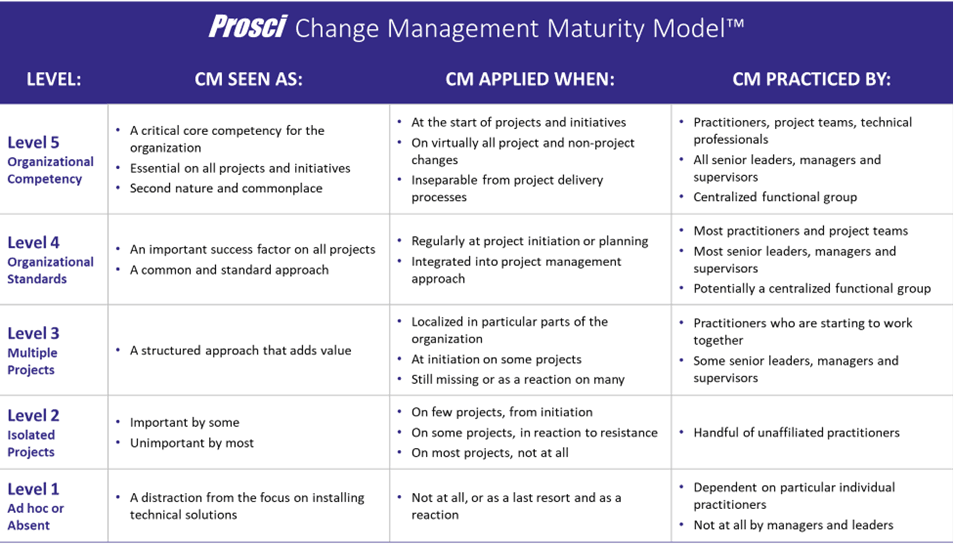

Change Management Blog
Using the Prosci Change Management Maturity Model™
January 8, 2023
Talal I. El-Assaad: Enterprise Transformation, CX Mastery & Go-to-Market Leadership
Time to Read: 6 Min

With the velocity of change and the demand to deliver expected outcomes and results increasing, leaders are recognizing that organizational change maturity is no longer a luxury but is in fact a necessity. Prosci began its research and development on embedding organizational change capability back in 2004 with the development and release of the Prosci Change Management Maturity Model™. The Prosci Maturity Model has enabled countless organizations to document their current level of maturity and develop actionable plans to increase their maturity.
This article provides an overview of the Prosci Maturity Model and the associated Prosci Maturity Model Audit, which provides a quantitative diagnostic of maturity. It concludes with four primary use cases for applying the Prosci Maturity Model, identified by advanced practitioners at a recent industry event:
Measuring maturity
Aligning stakeholders
Guiding actions
Clarifying approach
Prosci Change Management Maturity Framework
The five levels of organizational maturity in Change Management are:
Level 5: Organizational Competency
Level 4: Organizational Standards
Level 3: Multiple Projects
Level 2: Isolated Projects
Level 1: Absent or Ad hoc
As organizations progress through the Prosci Maturity Model, Change Management becomes more prevalent across various projects and organizational sectors. Employees increasingly engage in and comprehend their roles in successful change, reflecting their relation to the change process. The organization actively works to incorporate Change Management across multiple functions, leading to enhanced success in projects and initiatives, as demonstrated by improved benefits realization and outcome achievement.

The above table outlines the perception, application, and practitioners of Change Management at each of the five levels defined in the Prosci Change Management Maturity Model. The table offers detailed insights into how Change Management evolves and becomes more integral to an organization's processes and culture as it progresses through the different levels of maturity.
Observations on Capability areas for Change Management Maturity
In refining the Prosci Maturity Model in 2012, Prosci analyzed and incorporated research and client feedback, leading to the identification of five key capability areas that signify Change Management maturity.
Each of these areas represents a distinct aspect of an organization's capability in managing change effectively and serves as a benchmark for assessing and developing their Change Management proficiency.
Let’s explore each of the 5 capability areas for CM Maturity:
Capability Area 1: Leadership
The "Leadership" capability area in the Prosci Change Management Maturity Model focuses on the commitment and actions of leaders in building Change Management competencies within the organization. It examines the extent to which leadership communicates the importance of change management, their role in sponsoring and promoting it, and efforts to build internal competencies in this area. Organizations scoring low in this area are advised to prioritize enhancing leadership's role in Change Management to strengthen their overall change competency.
Capability Area 2: Application
The "Application" capability area of the Prosci Change Management Maturity Model assesses the practical use of Change Management processes and tools in your organization's projects and initiatives. It involves evaluating the extent to which Change Management is applied across various projects, the availability of resources and funding for these efforts, and the organization-wide commitment to implementing Change Management practices. This area highlights the importance of not just understanding but also actively embedding & applying Change Management methodologies in the organization's daily operations.
Capability Area 3: Competencies
The "Competencies" capability area in the Prosci Change Management Maturity Model focuses on the training and development of those key roles who apply Change Management within the organization, including employees, managers, and leaders. This area assesses the extent of Change Management training provided and whether those trained have demonstrated effective Change Management competencies in their roles. It's about evaluating the depth and effectiveness of Change Management skills across the organization.
Capability Area 4: Standardization
The "Standardization" capability area in the Prosci Change Management Maturity Model examines the systems and mechanisms for embedding Change Management into an organization's practices. It looks at whether a consistent Change Management approach is applied across all areas, its integration with Project Management, and its inclusion in other improvement strategies. This capability area is critical for ensuring that Change Management becomes a fundamental and consistent part of the organization's approach to implementing change.
Capability Area 5: Socialization
The "Socialization" capability area, the 5th and final in the Prosci Change Management Maturity Model, is centered on cultivating organization-wide commitment and support for change management. This entails fostering a mindset where Change Management is seen as a key competitive advantage and an integral part of the organizational competency. It involves ensuring that Change Management principles and best practices are well understood and consistently applied across all levels, reinforcing its importance, and sustaining its practices throughout the organization.
Prosci Change Management Maturity Model Evaluation
The Prosci Maturity Model Audit is a comprehensive assessment tool that evaluates an organization's Change Management Maturity by examining 50 specific observable traits across the five capability areas.
It involves a detailed analysis of 50 specific, traits across the five identified capability areas. This evaluation uses a rubric scoring system to provide a clear and structured assessment of each trait, to provide a detailed and nuanced understanding of an organization's strengths and areas for improvement in change management.
Each factor includes descriptions corresponding to the five levels of maturity, ranging from Level 1 to Level 5. By selecting the description that most accurately reflects their organization's current state for each factor, leaders can develop a comprehensive and sophisticated understanding of their organization's proficiency in change management.
This methodical approach helps in constructing a comprehensive and detailed picture of the organization's proficiency and practices in change management.
Using the Prosci CM Maturity Model
The Prosci Maturity Model stands as a crucial tool for change leaders, enhancing the flexibility and resilience of their organizations. The model and its audit provide valuable insights for the broader application of Change Management within an organization.
During a recent convention of change deployment leaders, a collaborative effort identified four primary applications of the Prosci Maturity Model Audit, demonstrating its versatility and utility in guiding organizational change initiatives. These 4 main uses are:
Measuring maturity: To baseline your current level of Change Management maturity, set future maturity goals, and track progress in their Enterprise Change Management journey, thereby providing a clear roadmap for enhancing their change management capabilities.
Aligning stakeholders: To create a common understanding of Change Management maturity among stakeholders, even those not deeply familiar with Change Management concepts. It facilitates alignment and engagement with key stakeholders and decision-makers, promoting a unified approach to the Enterprise Change Management Journey. This includes aligning partners, creating a shared understanding across teams, securing senior leadership commitment, justifying ECM investments, managing expectations, and standardizing the perception of Change Management maturity levels within the organization.
Guiding actions: To aid in formulating actionable strategies & set a baseline and target maturity level. It guides in creating a roadmap to maturity, enhancing ECM strategies, assigning specific tasks and roles, making informed decisions on key areas, and prioritizing steps. This approach ensures a focused and practical progression towards enhanced Change Management capabilities.
Clarifying approach: It provides a structured method to understand and communicate what "maturity" means in this context: defining maturity clearly, updating stakeholders on progress, simplifying the process of achieving maturity, educating about Change Management, making the concept of maturity tangible, and sharing the developmental roadmap with relevant parties.
To effectively navigate rapid changes and enhance project ROI, organizations must evolve their operational approach, particularly in change management. The Prosci Change Management Maturity Model and its accompanying audit provide essential insights for assessing and developing an organization's Change Management maturity. Advancing through the maturity levels enhances focus on the human aspect of change, a key driver for successful project and initiative outcomes. This strategic approach is crucial for organizations aiming to keep pace with change and achieve better results.
